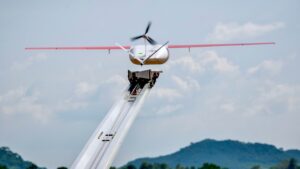
[ad_1]
 Zipline, a San Francisco-based company specializing in drone deliveries, has achieved a significant milestone by completing over 800,000 deliveries across seven countries since its establishment in 2011. The company, valued at over $4 billion after securing $330 million in recent funding, has expanded its services to include partnerships with notable entities such as Seattle’s Pagliacci Pizza, GNC, Intermountain Health, OhioHealth, and Michigan Medicine.
Zipline, a San Francisco-based company specializing in drone deliveries, has achieved a significant milestone by completing over 800,000 deliveries across seven countries since its establishment in 2011. The company, valued at over $4 billion after securing $330 million in recent funding, has expanded its services to include partnerships with notable entities such as Seattle’s Pagliacci Pizza, GNC, Intermountain Health, OhioHealth, and Michigan Medicine.
The Zipline, NVIDIA Techology
A key factor in Zipline’s success lies in its innovative use of the NVIDIA Jetson edge AI and robotics platform to power its drone fleet. Zipline’s drones, having covered more than 55 million miles, leverage the capabilities of the Jetson Xavier NX system-on-module for autonomous navigation and precision landings. This technology allows the drones to process sensor inputs, employ GPS, air traffic control communications, inertial measurement unit sensors, and an onboard detection and avoidance system, ensuring safe and accurate deliveries.
A.J. Frantz, Navigation Lead at Zipline, highlighted the significance of the NVIDIA Jetson module: “The NVIDIA Jetson module in the wing is part of what delivers our acoustic detection and avoidance system, so it allows us to listen for other aircraft in the airspace around us and plot trajectories that avoid any conflict,” said A.J. Frantz.
Zipline operates two main drone platforms. The P1 drone, in service for seven years, utilizes the Jetson Xavier NX system for processing sensor inputs, ensuring safe and efficient autonomous flights. On the other hand, the P2 drone, equipped with two Jetson Orin NX modules, is designed for hybrid functionality, offering the ability to hover and carry eight pounds of cargo for 10 miles. The redundancy in the drone’s design enhances safety, with one module dedicated to sensor fusion and the other integrated into the delivery droid.
Joseph Mardall, Head of Engineering at Zipline, explained that the P2 drone aims to integrate seamlessly into people’s lives, providing a quick, safe, and precise delivery experience.
The company’s drones, affectionately called ‘Zips,’ offer delivery times that are 7 times faster than traditional vehicle deliveries. “Our aircraft fly at 70 miles per hour, as the crow flies, so no traffic, no waiting at lights — we’re talking minutes here in terms of delivery times,” said Mardall. “Single-digit minutes are common for deliveries, so it’s faster than any alternative, for sure.”
Zipline’s customer roster includes prominent names such as Walmart, Sweetgreen, MultiCare Health Systems, and the government of Rwanda. The company’s initial focus on delivering blood in Rwanda has expanded to include food and convenience items.
In addition to its operational efficiency, Zipline is committed to environmental sustainability. The use of NVIDIA Jetson Orin modules contributes to energy efficiency in autonomous machines. Zipline reports a 97% reduction in carbon emissions compared to traditional gasoline-driven vehicles, aligning with their commitment to minimizing environmental impact.
Frantz and Mardell emphasized the importance of leveraging Jetson-driven applications for sustainability, noting the potential of next-generation electric-driven autonomous machines to replace those contributing to pollution. “We are super excited to significantly reduce carbon emissions,” said Mardall. “And when building an electric aircraft, efficiency is totally key — every watt, every fraction of a watt, every joule that we can claw back can be turned into payload and range.”
As Zipline continues to revolutionize the delivery industry with its cutting-edge technology and commitment to sustainability, the company remains a key player in the drone delivery landscape.
Read more:
Miriam McNabb is the Editor-in-Chief of DRONELIFE and CEO of JobForDrones, a professional drone services marketplace, and a fascinated observer of the emerging drone industry and the regulatory environment for drones. Miriam has penned over 3,000 articles focused on the commercial drone space and is an international speaker and recognized figure in the industry. Miriam has a degree from the University of Chicago and over 20 years of experience in high tech sales and marketing for new technologies.
For drone industry consulting or writing, Email Miriam.
TWITTER:@spaldingbarker
Subscribe to DroneLife here.
[ad_2]